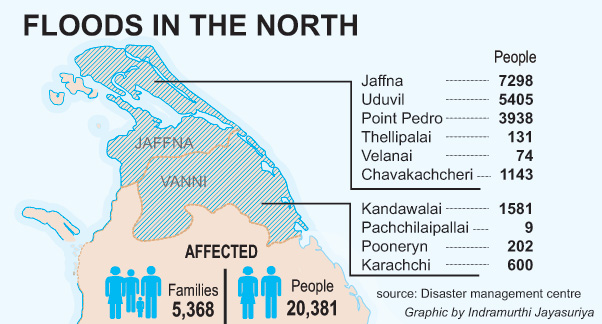News
20,000 affected by torrential rains
Torrential rains continued in the Northern, Southern and South-Western parts of the country, affecting over 20,000 persons. In the Jaffna district, the lives of more than 17,000 persons have been disrupted by the floods. The deluge of rainwater Jaffna received in the past two weeks has stagnated, which is prolonging the flood situation, said the District Disaster Management Coordinating Unit’s Assistant Director, S. Ravi.
As most of Jaffna consists of low lying areas such as Navanthurai, Vasanthaturam and the Jaffna Fort which lie below the lagoon’s water level, sea water seeps into the ground water, making it brackish. Many of the flood victims were without drinking water and sanitation facilities. The authorities have identified 1,000 flood prone areas in Jaffna and implemented flood mitigation projects such as digging gullies and renovating tank bunds.
They have also put in place 10 emergency refugee camps to house victims of natural disasters. However, a single weather abnormality would make such preparations useless due to Jaffna’s geography. According to data collected by the Disaster Management Centre (DMC), 2,392 Kilinochchi residents living in Poonaryn, Karachchi and Pachchilaipallai have been affected by the floods.
The main reason for houses going under water in Killinochchi is because of low foundations. Many living in the district are poor war victims who can’t elevate their houses despite construction rules set by the UDA, said an official of the DMC. Sri Lanka and the surrounding Indian Ocean is currently experiencing turbulent weather conditions because of the atmosphere transiting from the inter-monsoonal phase to the North-East monsoon season, said the Meteorology Department’s Duty Forecaster, Malith Fernando.
“Wind behaviour, together with high levels of water evaporation, is what is causing the floods. These two factors would bring heavy rain to Galle and Hambantota in the coming days,” he added. Floods can be mitigated to a certain extent by simple acts like educating citizens, not throwing garbage into rivers and preparing flood prone areas to withstand floods, said the Irrigation Department’s Director of Works General and Building Services, B.A. Kanthi Chandralatha.


